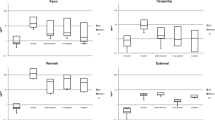Summary
The effects of co-exposure of hexane and toluene were investigated in field surveys and animal experiments. One field survey suggested that increase of hexane content in adhesives might have caused an outbreak of polyneuropathy in a vinyl sandal manufacture in Japan. The animal experiments proved that co-exposure of hexane and toluene decrease hexane neurotoxicity and urinary excretion of hexane metabolites in rats. The results also suggested that toluene might inhibit metabolism of hexane. Another recent field survey indicated that the ratio of urinary 2,5-hexanedione to hexane exposure in the workers co-exposed to hexane and toluene decreased in parallel with in more crease of toluene concentration. The results indicated that urinary excretion of 2,5-hexanedione could be depressed by co-exposure of toluene even in the workers exposed to relatively low concentrations. These above-mentioned results suggest that co-exposure of hexane and toluene could inhibit hexane metabolism and decrease hexane neurotoxicity in both experimental animals and workers. Although metabolism of hexane could be easily modified by toluene or other solvents and might not be a good indicator for hexane exposure in mixed exposure, urinary 2,5-hexanedione might be a good indicator for neurotoxicity of hexane even in mixed exposure.
Similar content being viewed by others
References
ACGIH (1991) Threshold limit values for chemical substances and physical agents and biological exposure indices. ACGIH, Cincinnati
Altenkirch H, Stoltenburg G, Wagner HM (1978) Experimental studies on hydrocarbon neuropathies induced by methyl ethyl ketone. J Neurol 219:159–170
DFG (1991) Maximum concentrations at the workplace and biological tolerance values for working materials 1991. VCH, Weinheim
Fedtke N, Bolt HM (1987) The relevance of 4,5-dihydroxy-2-hexanone in the excretion kinetics of n-hexane metabolites in rat and man. Arch Toxicol 61:131–137
Inoue T, Takeuchi Y, Takeuchi S, Yamada S, Suzuki H, Matsusita T, Miyagaki H, Maeda K, Matsumoto T (1970) A health survey on vinyl sandal manufacturers with high incidence of n-hexane intoxication. Jpn J Ind Health 1970:73–84
Iwata M, Takeuchi Y, Hisanaga N, Ono Y (1983) Changes of n-hexane metabolites in urine of rats exposed to various concentrations of n-hexane and its mixture with toluene or MEK. Int Arch Occup Environ Health 53:1–8
Iwata M, Takeuchi Y, Hisanaga N, Ono Y (1984) Changes of n-hexane neurotoxicity and its metabolites by long-term co-exposure with MEK or toluene. Int Arch Occup Environ Health 54:273–281
Muni A, Falzoi M, Lucertini S, Arfini G, Magda Zignani, Lombardi S, Frantini I (1984) n-Hexane metabolism in occupationally exposed workers. Brit J Ind Med 41:533–538
Nylen P, Ebendal T, Eriksdotter-Nilsson M, Hasson T, Henshen A, Johnson AC, Kronevi T, Kvist U, Sjostrand NO, Hoglund G, Olson (1989) Testicular atrophy and loss of nerve growth factor-immunoreactive germ cell line in rats exposed to n-hexane and a protective effect of simultaneous exposure to toluene or xylene. Arch Toxicol 63:296–307
Ono Y, Takeuchi Y, Hisanaga N (1980) A comparative study of the toxicity of petroleum benzine and n-hexane. Proc 8th Conf Occup Health in Chemical Industry:1261 32
Ono Y, Takeuchi Y, Hisanaga N (1981) A comparative study on the toxicity of n-hexane and its isomers on the peripheral nerve. Int Arch Occup Health 48:289–294
Perbellini L, Brugnone F, Faggionati I (1981) Urinary excretion of the metabolites of n-hexane and its isomers during occupational exposure. Brit J Ind Med 38:20–26
Perbellini L, Leone R, Fracasso ME, Brugnone F, Venturini Mg (1982) Metabolic interaction between n-hexane and toluene in vivo and in vitro. Int Arch Occup Environ Health 50:351–358
Saito I, Shibata E, Huang J, Hisanaga N, Ono Y, Takeuchi Y (1991) Determination of urinary 2,5-hexanedione concentration by an improved analytical method as an index of exposure. Brit J Ind Med 48:568–574
Takeuchi Y, Mabuchi C, Takagi S (1975) Polyneuropathy caused by petroleum benzine. Int Arch Arbeitsmed 34:185–197
Takeuchi Y, Ono Y, Hisanaga N, Inoue T (1980) Toxicity and doseresponse (effect) relationship of n-hexane. Jpn J Ind Health 22:470–487
Takeuchi Y, Ono Y, Hisanaga N (1981) An experimental study on the combined effects of n-hexane and toluene on the peripheral nerve of the rat. Brit J Ind Med 38:14–19
Yamamura Y (1969) n-Hexane polyneuropathy. Folia Physh et Neurol Jpn 23:45–57
Author information
Authors and Affiliations
Rights and permissions
About this article
Cite this article
Takeuchi, Y., Hisanaga, N., Ono, Y. et al. Modification of metabolism and neurotoxicity of hexane by co-exposure of toluene. Int. Arch Occup Environ Heath 65 (Suppl 1), S227–S230 (1993). https://doi.org/10.1007/BF00381347
Issue Date:
DOI: https://doi.org/10.1007/BF00381347




